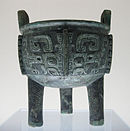
Back Brons AF Bronze ALS ናስ AM Bronce AN कांसा ANP برونز Arabic برونز ARZ Bronce AST Tunc AZ Бронза BA
Bronze is an alloy consisting primarily of copper, commonly with about 12–12.5% tin and often with the addition of other metals (including aluminium, manganese, nickel, or zinc) and sometimes non-metals, such as phosphorus, or metalloids, such as arsenic or silicon. These additions produce a range of alloys that may be harder than copper alone, or have other useful properties, such as strength, ductility, or machinability.
The archaeological period in which bronze was the hardest metal in widespread use is known as the Bronze Age. The beginning of the Bronze Age in western Eurasia and India is conventionally dated to the mid-4th millennium BC (~3500 BC), and to the early 2nd millennium BC in China;[1] elsewhere it gradually spread across regions. The Bronze Age was followed by the Iron Age starting about 1300 BC and reaching most of Eurasia by about 500 BC, although bronze continued to be much more widely used than it is in modern times.
Because historical artworks were often made of brasses (copper and zinc) and bronzes of different metallic compositions, modern museum and scholarly descriptions of older artworks increasingly use the generalized term "copper alloy" instead of the names of individual alloys. This is done (at least in part) to prevent database searches from failing merely because of errors or disagreements in the naming of historic copper alloys.[2]
- ^ Thorp, Robert L. (2013). China in the Early Bronze Age: Shang Civilization. University of Pennsylvania Press.[page needed]
- ^ "British Museum, "Scope Note" for "copper alloy"". British Museum. Archived from the original on 18 August 2014. Retrieved 14 September 2014.



